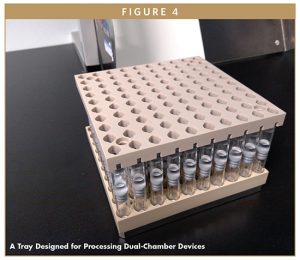Issue:October 2019
COMBINATION PRODUCT DEVELOPMENT - New Horizons in Development to Meet Emerging Demands
INTRODUCTION
The healthcare landscape has changed significantly throughout the past several years as the delivery of care has moved rapidly toward more economical and non-institutional settings. Just as many surgical procedures have moved from the hospital to the outpatient setting, the administration of injectable medications for chronic diseases has moved from formal healthcare settings to the home. This requires the product and delivery system to be conducive for non-healthcare professional users, self-injecting patients and their support system, to easily and successfully administer medications. This is reflected in the projections for the self-injections market to grow more than 22% annually toward $119 billion by 2024.1 The course of therapy to treat chronic conditions is often an injected biologic, contributing to the forecasted growth for biologics of 10.9% CAGR to $480 billion in 2024.2 Many of these biologics, such as plasma proteins, vaccines, monoclonal antibodies, and oligonucleotides, as well as some small molecules, require lyophilization because they are unstable as aqueous solutions. The lyophilized dried form provides suitable preservation for adequate long-term storage, yet requires conversion into an aqueous solution at the point of care.
The new expectation is to couple the needs of a course of therapeutic treatment with a patient-centric delivery system. In the emerging horizon, less- experienced users must deliver more complex formulations by using more sophisticated delivery systems. Thus, conventional approaches to product design, formulation, and manufacturing are quickly becoming antiquated. In today’s environment, it is no longer sufficient to put a product in a vial. The future of healthcare products places increasing demands on the industry to provide innovations for delivering combination products. The dual-chamber reconstitution system is a prime example of a combination product that can meet the evolving industry and patient needs. The challenge is that such combination products will require clinical, device, formulation, and process innovation as well as collaboration within the supply chain. Credence MedSystems and Lyophilization Technology, Inc. (LTI) are collaborating closely to advance the development of a dual-chamber combination product offering to the industry.
SAFETY, USABILITY & TOTAL COST REQUIREMENTS FOR AN EFFECTIVE SOLUTION
Contemporary approaches to product design must consider essential aspects in delivering the needed course of therapy all the way to the patient; this includes patient safety, usability, and total cost. Requirements to design a combination product with a patient-centric perspective have implications on both the delivery device and the development of a lyophilized drug product.
Safety
It is essential the correct composition is delivered at the time of administration. Proper reconstitution requires a high level of accuracy and precision in the quantity of active and diluent to prepare the final injectable solution. The ideal product design to create an effective delivery system would ensure the correct composition by combining the active product formulation and diluent together in the same primary packaging. It is imperative to achieve proper and complete reconstitution; and reconstitution time is more critical in a dual-chamber product compared to a lyophilized product in a vial. This is integral to patient compliance because dissolution challenges or longer reconstitution times can increase the risk of an injection prior to forming a complete solution.
Opportunities also exist to improve the safety and reduce the complexity associated with the preparation of a conventional lyophilized product in a vial, which can commonly require over 15 steps to prepare for administration.3 Such complexity introduces significant opportunities for error, the potential for needlestick injury, and the risk of contamination. Furthermore, a delivery device that automatically deactivates the needle following injection and prevents reuse of the system can further improve user safety.
Usability
Self-injectors need an intuitive, easyto- use, and safe device to effectively deliver an injectable product and to have the greatest opportunity for patient compliance. Like the easy-to-open pill container for arthritic patients, an injectable delivery system must be readily activated and the product easily administered. Patient convenience and user preference must also be considered.
Traditionally, self-injectors are divided in their preference between using a syringe alone (a “naked” syringe), which provides more control, and using an autoinjector, which helps to automate the injection. This warrants developing a product that can be used alone as a syringe as well as within an autoinjector. Applicable to any injected product, ensuring the full dose is delivered is essential. Here again, designs of a syringe system and a compatible autoinjector both need to incorporate aspects to ensure proper dosing.
For a lyophilized combination product, there is a unique and demanding need to revert the dried product and diluent to form a complete solution. Complete diluent transfer is critical. The means in which the diluent is presented to the API may also be a factor. Complete “wettability” with full distribution and exposure of the dried product to the diluent is imperative. With products that are shear sensitive, such as some polypeptides and proteins, the velocity of diluent introduction can create irreversible denaturation. All of these factors must be considered in the diluent transfer and delivery device design.
Total Cost
Conventional presentations of a lyophilized product in a vial can require multiple vials, syringes, needles, and vial adapters, as well as ancillary components like cotton swabs or sanitizing wipes. Figure 1 shows a representative example of the several components needed for preparing and delivering a conventional lyophilized preparation. To support the conventional product throughout the supply chain, this presentation requires a greater logistical burden to our healthcare system for the cost of managing and maintaining inventory, distribution, storage, packaging, and materials. Additionally, in a formal healthcare setting, the time and effort to navigate the complex preparation process discussed earlier must be factored into the total cost of delivering the drug to the patient. Finally, the cost of overfilling, and adverse events related to needlestick, inaccurate dosing, mishandling, or contamination, represent meaningful factors when assessing the total cost of drug delivery.
ACHIEVING A SAFE, EFFECTIVE & EASY-TO-USE PATIENT-CENTRIC DRUG DELIVERY SYSTEM
Meeting the needs for a patient-centric reconstitution and delivery system requires innovation in delivery system design, formulation, and process engineering. The requirements are affected by factors, such as product indication, drug product characteristics, and injection volume. The setting for product use is another important factor; requirements differ in specialty applications, such as ambulatory and institutional emergency, dermatology, and ophthalmology, when compared to self-administration in the home. As such, enhanced design and device flexibility allows for development of combination products most suited for their intended use.
Delivery System Design
An example of a dual-chamber lyophilized product delivery system designed to be patient-centric is the Companion® Dual Chamber Reconstitution Syringe. By storing the lyophilized product with the diluent in a single primary packaging device that is also the delivery system, the Companion® Dual Chamber provides the required storage conditions while maximizing the safety, effectiveness, and ease-of-use for a patient administering lyophilized medications.
The Companion® Dual Chamber allows use of a standard syringe or cartridge barrel and standard plunger, preserving the use of preferred commercially available primary package components. The design eliminates the presence of the adhesive conventionally used to affix a staked needle into a syringe barrel, thereby removing a substance that risks detrimental impact to the product. The system and technology are compatible with multiple syringe barrel sizes, bringing the advantages of optimized package size and improved ergonomics. This is increasingly important as injection volumes for subcutaneous (Sub-Q) administration get larger. Historically in the 1.0-Ml range, we are now seeing higher volumes injected Sub-Q; Sanofi’s Dupilumab, a 2-mL Sub-Q abdominal injection, is a prime example.
Use of the Companion® Dual Chamber device entails two straight-forward steps for preparing and administering a lyophilized drug product. In the first step, the user pushes on the plunger rod to readily transfer diluent from the rear to the front chamber, reconstituting the lyophilized cake to form a solution. As seen in Figure 2, an internal transfer path eliminates the need for an external bypass for the glass barrel. Once reconstitution is complete, the user continues to press the plunger rod to administer the injection until a tactile and audible end-of-dose click confirms that the full dose has been delivered. The needle then retracts seamlessly into the plunger rod, protecting the user and disabling the syringe from reuse. This dual-chamber system consolidates multiple features into one device: reconstitution; user-feedback; passive needlestick safety; reuse prevention; and the familiarity of a staked-needle syringe that allows conventional syringe operation.
Further flexibility is provided in that the Companion® Dual Chamber can also be combined with a user-attached needle or used with needleless adapters. A user-attached needle is suited for intramuscular (IM) injections when the preferred needle size is chosen at the time of injection, while the needleless version is more suitable for delivering the reconstituted solution into an IV bag or line for intravenous administration. The assembled Companion® Dual Chamber Syringe can also be incorporated into an autoinjector, allowing the same primary package to be used as a “naked” syringe or in device-assisted administration. This design platform offers sufficient flexibility for multiple applications as listed earlier. The Credence Companion® Dual Chamber Reconstitution System presents a safe and effective way to allow both non-professional users and healthcare providers alike to safely and more easily deliver lyophilized drug products in various settings.
Formulation Development
There are several considerations in developing the formulation for a product housed in a combination product delivery system. The Quality Target Product Profile (QTPP), a precursor to the finished product Critical Quality Attributes (CQA), must be expanded beyond that for a product presented to a clinician in a vial. In addition to stabilizing the drug substance in both the liquid and solid states, the reconstituted solution must be immediately suitable for injection. This places more rigorous requirements when developing a formulation. It is most desirable that formulation constructs be isotonic and at or near physiological pH. The choice of excipients is also more critical than those for a vial-based product. For example, if a citric acid/sodium citrate buffer is the best choice for control of pH and optimal stability, there is a limit to the buffer concentration for a Sub-Q administration to avoid irritation at the injection site.
Specific excipients may be needed to improve drug substance solubility and dissolution. It is important to recognize there may be both a salting-in and salting-out effect. There may also be a strong influence of the formulation on reconstitution time. With a vial-based product, a reconstitution time of 2 minutes is readily accommodated, but this is unsuitable for a syringe. Reconstitution needs to be in the range of several seconds to enable better patient compliance, and instantaneous reconstitution is preferred. It is also important to consider compatibility of the formulation construct with silicone on the barrel and plunger.
Process Engineering
Figure 3 represents a method of filling/lyophilizing in the Companion® Dual Chamber Syringe that has supply chain and processing efficiencies. Unique to lyophilization, the geometry of the primary packaging has a significant impact on heat transfer, one of the rate-limiting factors for the process. With a conventional vial, the contour of the vial bottom and contact with the lyophilizer shelf is a key aspect of enabling heat transfer. The geometry of a syringe, and specifically the limited contact area with the lyophilizer shelf, makes the obtainable heat transfer a fraction of that relative to a vial. Therefore, the syringe needs to be processed in a specifically designed tray. To process the range of products including biopharmaceuticals, which tend to have a low critical threshold temperature for freezing and primary drying, the processing tray must satisfy the needs of aseptic processing as well as heat transfer during lyophilization. Figure 4 depicts the configuration of a specialized tray designed specifically for aseptic processing and lyophilization in dual chamber devices.
The syringe geometry also influences the height of the dried cake, which has a significant impact on the lyophilization process due to mass transfer of the water vapor from the sublimation of ice. The water vapor generated as the ice sublimes in primary drying must traverse through the dried layer above the sublimation front. The greater this height, and therefore the distance the water vapor needs to travel, the more resistance to the water vapor traveling through the dried layer above the sublimation front.
COLLABORATION IN THE SUPPLY CHAIN: INTEGRATING A UNIQUE COMBINATION PRODUCT INTO COMMERCIAL MANUFACTURING
Coupling expertise in drug product and process with that of drug delivery devices is essential to provide an innovative therapeutic to the industry, and most importantly, to the patient. The collaboration between Credence, a device developer and supplier, and LTI, a contract development and manufacturing organization, is a good example of a cooperation bringing value to the industry and its patients. The companies have collaborated to advance development of the dual-chamber product and associated fill-finish activities for both large and small pharma companies. To date, the collaboration has been focused on preclinical to early clinical development activities. The effort focuses on requirements beyond supporting the conventional development and product stability, including regulatory considerations, such as human factors and clinical studies.
Simply stated, if you do not have a product that can be manufactured at the scale required, you do not have a product. Development and manufacturing in the conventional presentation, in which a lyophilized product and diluent are in separate vials, are well established. Combining the preclinical and clinical drug product with the delivery device development presents distinctive challenges in advancing a combination product to the market. The collaboration between Credence and LTI is enabling achievement of development objectives in product design, formulation development, and equally important, engineering of the manufacturing process. Expanding to full production includes incorporating larger scale CMOs for commercial fill/finish, and collaboration with syringe manufacturers to integrate Companion® technology in the classic “ready-for-filling” configuration. Collaboration has been a key driver of the progress to date, and further collaboration in the supply chain is essential to achieve the goal: providing the patient a product that is effective in treating the condition and suitable for safe and proper administration in the chosen care setting.
REFERENCES
- Market Research Engine Nov 2018. Self-Injections Market By Route of Administration Analysis. Global Forecast by 2018-2024.
- Transparency Market Research Feb 2018. Biologics Market Size, Share, Growth, Sales, Trade, Pricing Forecast, Installed Bases, Export Value and Volume.
- https://dailymed.nlm.nih.gov/dailymed/index.cfm.
To view this issue and all back issues online, please visit www.drug-dev.com.

Ed Trappler has over 40 years of experience in lyophilization that includes product development, toxicology and clinical supply manufacturing, and parenteral production. In 1992, he founded Lyophilization Technology, Inc. as a source of scientific and technical services, expanding the knowledge and understanding of lyophilization. He has contributed to 6 books and authored and presented numerous papers and courses internationally. He has received numerous recognitions, is an active PDA member, serving as Chairperson of the Lyophilization Interest Group and Validation Task Force, and Education Advisory Board. The PDA awarded him the Gordon Personeous award for his contributions to the PDA and the James Agalloco award for education.

John A. Merhige is Chief Commercial Officer at Credence MedSystems, leading the company’s business development, sales, and marketing strategies. Previously, he was Vice President, Market Development at Sanofi, which he joined upon its acquisition of Pluromed, where he was a member of the Executive Management team. He also founded Prelude Devices to identify and grow early stage medical technology ventures. He graduated from Dartmouth College with a Mechanical Engineering degree and returned to Dartmouth for a Masters in Engineering Management from the Thayer School of Engineering and the Tuck School of Business.
Total Page Views: 12383














